Economic Analysis of Cash Rate and Financial Stability
VerifiedAdded on 2021/04/21
|18
|2930
|422
AI Summary
This assignment requires an analysis of the cash rate and its relationship with economic factors such as wage rates and inflation. It involves a discussion of the implications of the cash rate on employment growth and household spending, as well as its potential impact on retail sales and financial stability. The assignment aims to provide insights into the role of cash rate in maintaining economic stability and promoting sustainable growth.
Contribute Materials
Your contribution can guide someone’s learning journey. Share your
documents today.
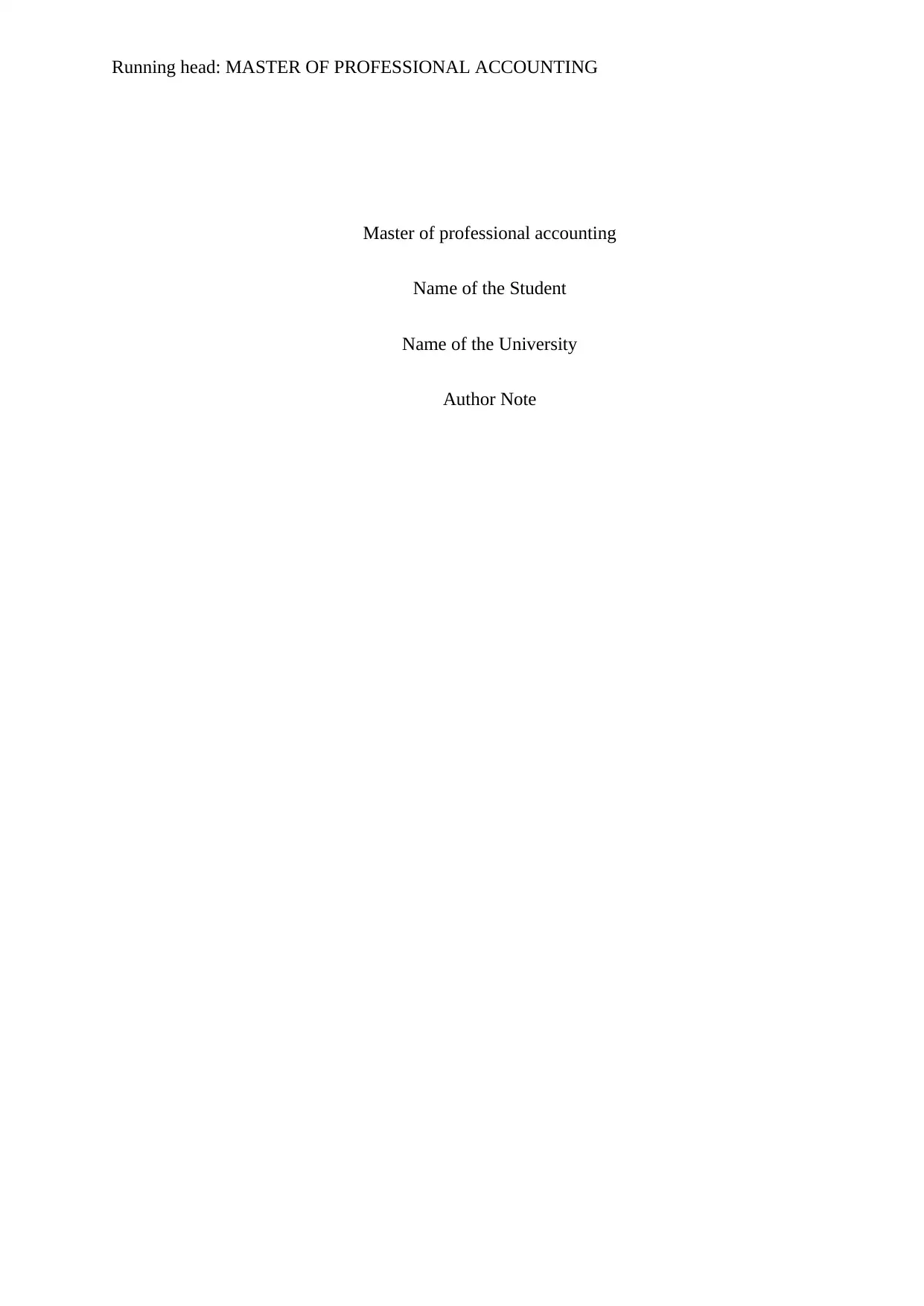
Running head: MASTER OF PROFESSIONAL ACCOUNTING
Master of professional accounting
Name of the Student
Name of the University
Author Note
Master of professional accounting
Name of the Student
Name of the University
Author Note
Secure Best Marks with AI Grader
Need help grading? Try our AI Grader for instant feedback on your assignments.
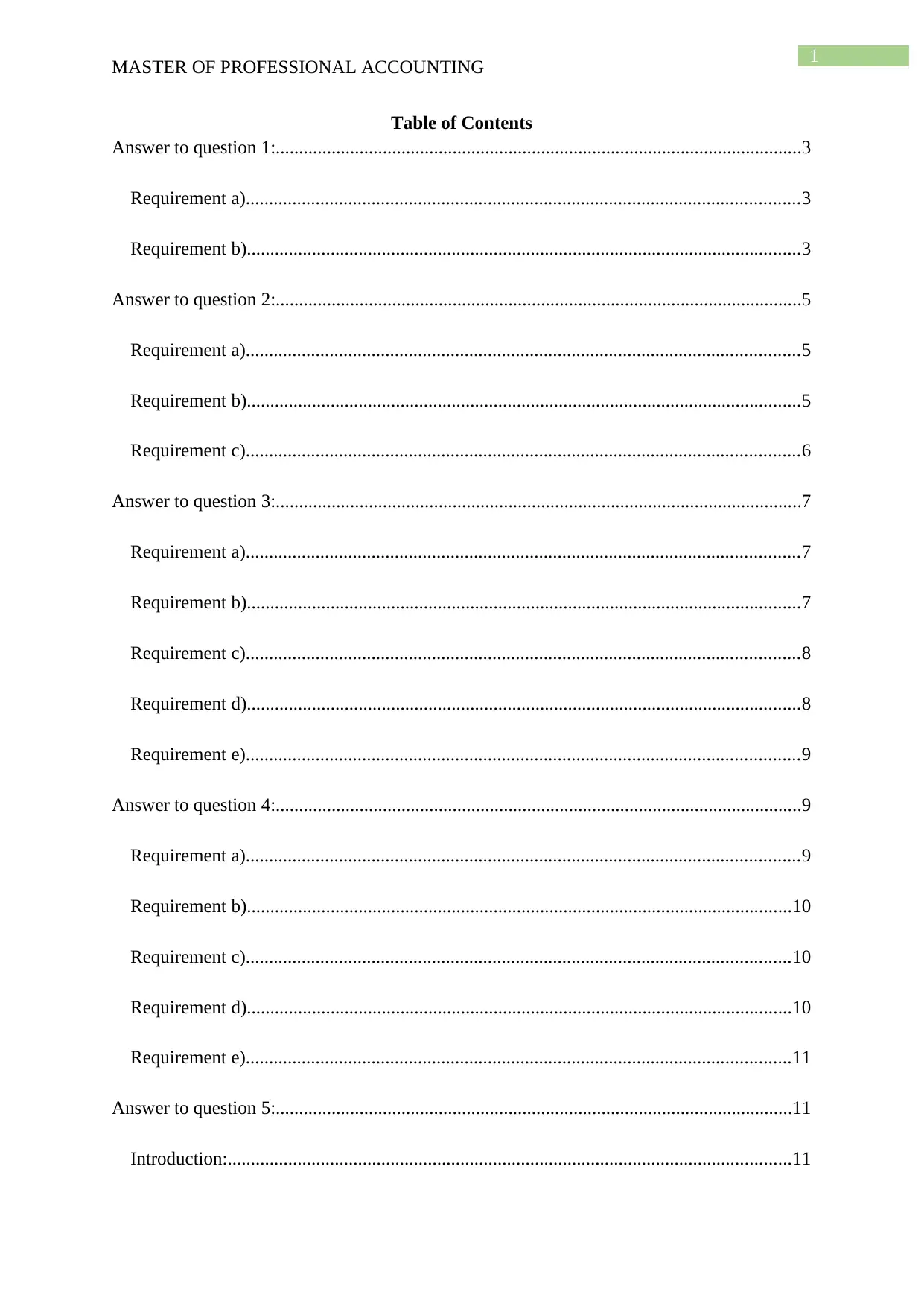
1
MASTER OF PROFESSIONAL ACCOUNTING
Table of Contents
Answer to question 1:.................................................................................................................3
Requirement a).......................................................................................................................3
Requirement b).......................................................................................................................3
Answer to question 2:.................................................................................................................5
Requirement a).......................................................................................................................5
Requirement b).......................................................................................................................5
Requirement c).......................................................................................................................6
Answer to question 3:.................................................................................................................7
Requirement a).......................................................................................................................7
Requirement b).......................................................................................................................7
Requirement c).......................................................................................................................8
Requirement d).......................................................................................................................8
Requirement e).......................................................................................................................9
Answer to question 4:.................................................................................................................9
Requirement a).......................................................................................................................9
Requirement b).....................................................................................................................10
Requirement c).....................................................................................................................10
Requirement d).....................................................................................................................10
Requirement e).....................................................................................................................11
Answer to question 5:...............................................................................................................11
Introduction:.........................................................................................................................11
MASTER OF PROFESSIONAL ACCOUNTING
Table of Contents
Answer to question 1:.................................................................................................................3
Requirement a).......................................................................................................................3
Requirement b).......................................................................................................................3
Answer to question 2:.................................................................................................................5
Requirement a).......................................................................................................................5
Requirement b).......................................................................................................................5
Requirement c).......................................................................................................................6
Answer to question 3:.................................................................................................................7
Requirement a).......................................................................................................................7
Requirement b).......................................................................................................................7
Requirement c).......................................................................................................................8
Requirement d).......................................................................................................................8
Requirement e).......................................................................................................................9
Answer to question 4:.................................................................................................................9
Requirement a).......................................................................................................................9
Requirement b).....................................................................................................................10
Requirement c).....................................................................................................................10
Requirement d).....................................................................................................................10
Requirement e).....................................................................................................................11
Answer to question 5:...............................................................................................................11
Introduction:.........................................................................................................................11
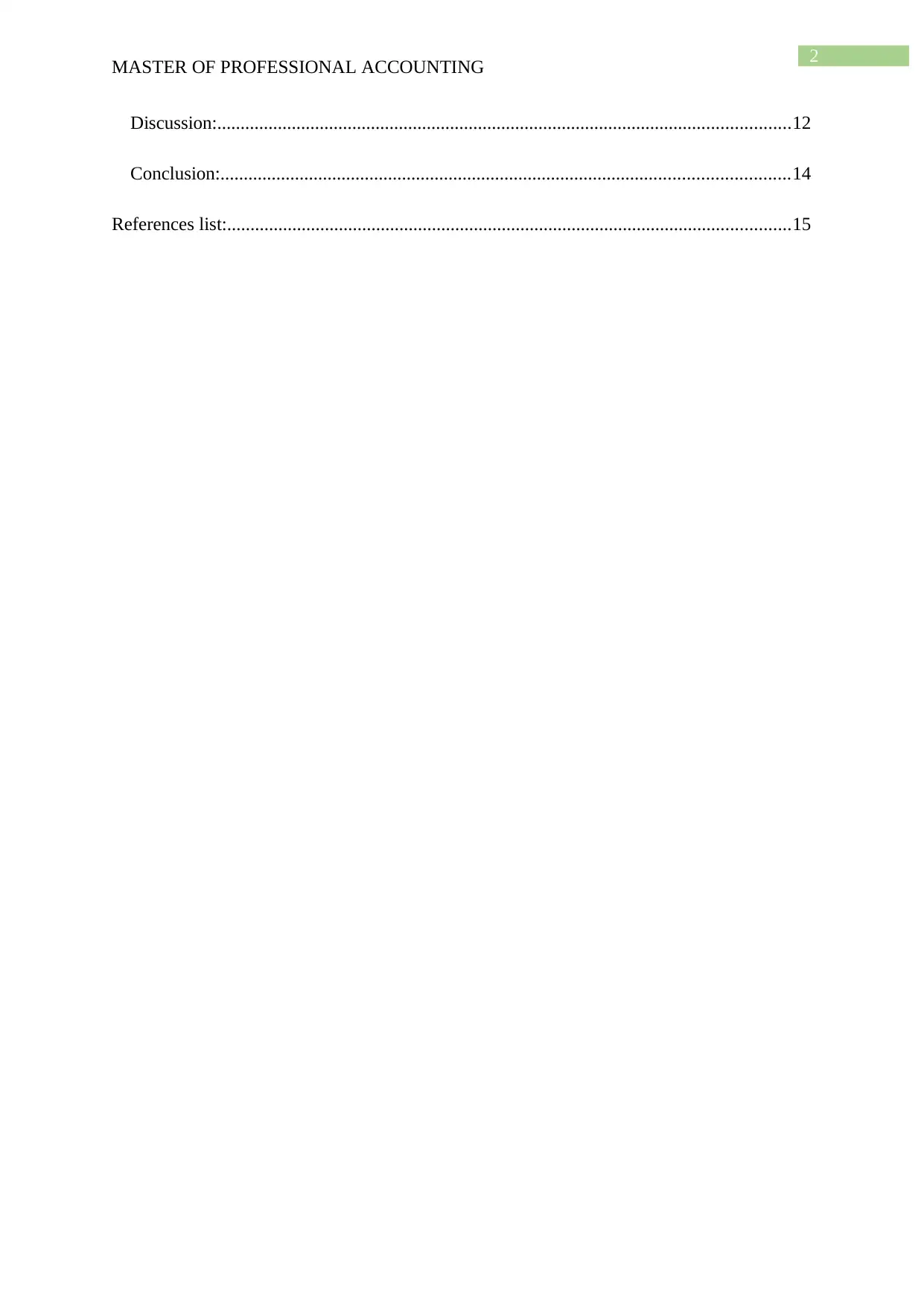
2
MASTER OF PROFESSIONAL ACCOUNTING
Discussion:...........................................................................................................................12
Conclusion:..........................................................................................................................14
References list:.........................................................................................................................15
MASTER OF PROFESSIONAL ACCOUNTING
Discussion:...........................................................................................................................12
Conclusion:..........................................................................................................................14
References list:.........................................................................................................................15
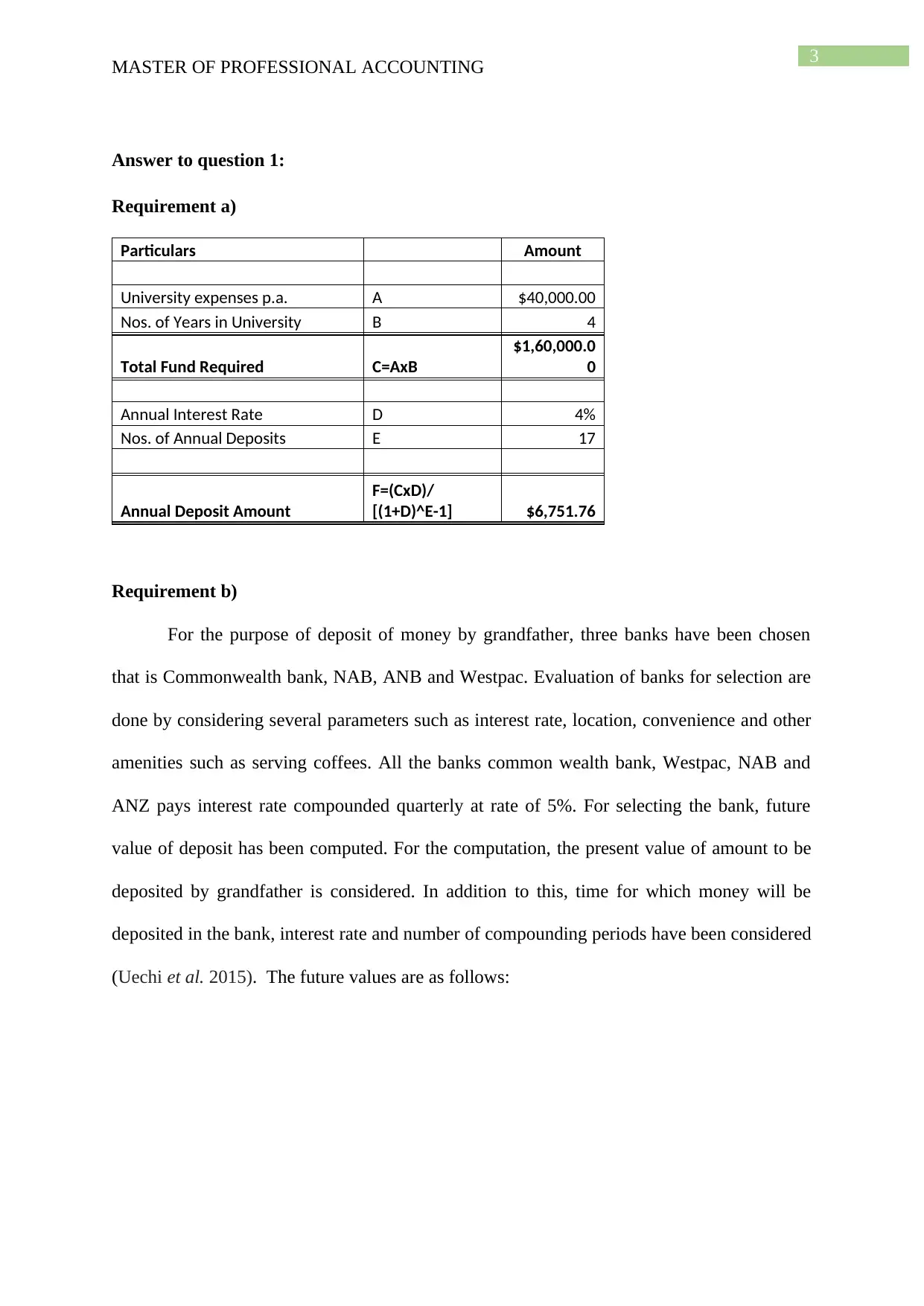
3
MASTER OF PROFESSIONAL ACCOUNTING
Answer to question 1:
Requirement a)
Particulars Amount
University expenses p.a. A $40,000.00
Nos. of Years in University B 4
Total Fund Required C=AxB
$1,60,000.0
0
Annual Interest Rate D 4%
Nos. of Annual Deposits E 17
Annual Deposit Amount
F=(CxD)/
[(1+D)^E-1] $6,751.76
Requirement b)
For the purpose of deposit of money by grandfather, three banks have been chosen
that is Commonwealth bank, NAB, ANB and Westpac. Evaluation of banks for selection are
done by considering several parameters such as interest rate, location, convenience and other
amenities such as serving coffees. All the banks common wealth bank, Westpac, NAB and
ANZ pays interest rate compounded quarterly at rate of 5%. For selecting the bank, future
value of deposit has been computed. For the computation, the present value of amount to be
deposited by grandfather is considered. In addition to this, time for which money will be
deposited in the bank, interest rate and number of compounding periods have been considered
(Uechi et al. 2015). The future values are as follows:
MASTER OF PROFESSIONAL ACCOUNTING
Answer to question 1:
Requirement a)
Particulars Amount
University expenses p.a. A $40,000.00
Nos. of Years in University B 4
Total Fund Required C=AxB
$1,60,000.0
0
Annual Interest Rate D 4%
Nos. of Annual Deposits E 17
Annual Deposit Amount
F=(CxD)/
[(1+D)^E-1] $6,751.76
Requirement b)
For the purpose of deposit of money by grandfather, three banks have been chosen
that is Commonwealth bank, NAB, ANB and Westpac. Evaluation of banks for selection are
done by considering several parameters such as interest rate, location, convenience and other
amenities such as serving coffees. All the banks common wealth bank, Westpac, NAB and
ANZ pays interest rate compounded quarterly at rate of 5%. For selecting the bank, future
value of deposit has been computed. For the computation, the present value of amount to be
deposited by grandfather is considered. In addition to this, time for which money will be
deposited in the bank, interest rate and number of compounding periods have been considered
(Uechi et al. 2015). The future values are as follows:
Secure Best Marks with AI Grader
Need help grading? Try our AI Grader for instant feedback on your assignments.
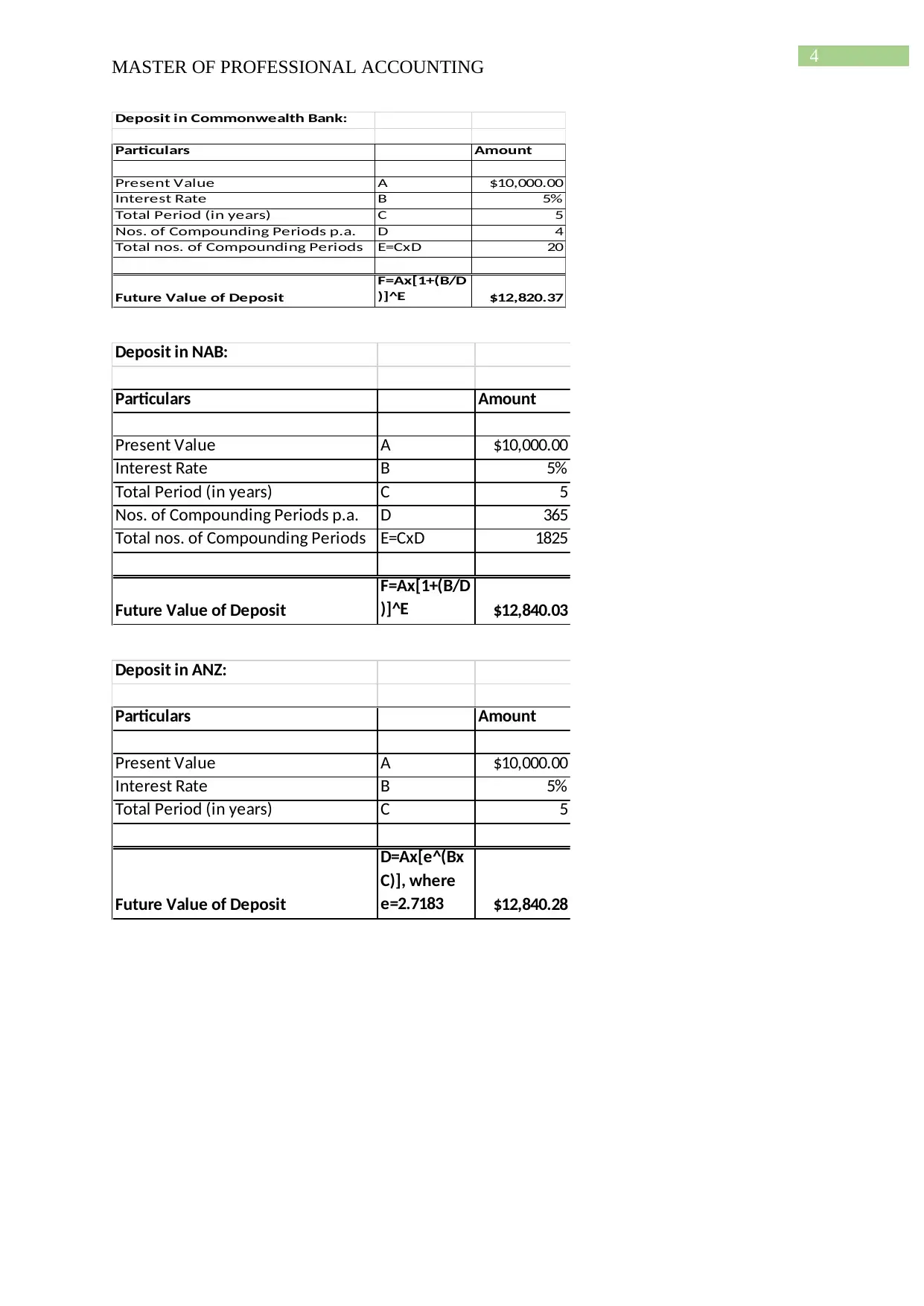
4
MASTER OF PROFESSIONAL ACCOUNTING
Deposit in Commonwealth Bank:
Particulars Amount
Present Value A $10,000.00
Interest Rate B 5%
Total Period (in years) C 5
Nos. of Compounding Periods p.a. D 4
Total nos. of Compounding Periods E=CxD 20
Future Value of Deposit
F=Ax[1+(B/D
)]^E $12,820.37
Deposit in NAB:
Particulars Amount
Present Value A $10,000.00
Interest Rate B 5%
Total Period (in years) C 5
Nos. of Compounding Periods p.a. D 365
Total nos. of Compounding Periods E=CxD 1825
Future Value of Deposit
F=Ax[1+(B/D
)]^E $12,840.03
Deposit in ANZ:
Particulars Amount
Present Value A $10,000.00
Interest Rate B 5%
Total Period (in years) C 5
Future Value of Deposit
D=Ax[e^(Bx
C)], where
e=2.7183 $12,840.28
MASTER OF PROFESSIONAL ACCOUNTING
Deposit in Commonwealth Bank:
Particulars Amount
Present Value A $10,000.00
Interest Rate B 5%
Total Period (in years) C 5
Nos. of Compounding Periods p.a. D 4
Total nos. of Compounding Periods E=CxD 20
Future Value of Deposit
F=Ax[1+(B/D
)]^E $12,820.37
Deposit in NAB:
Particulars Amount
Present Value A $10,000.00
Interest Rate B 5%
Total Period (in years) C 5
Nos. of Compounding Periods p.a. D 365
Total nos. of Compounding Periods E=CxD 1825
Future Value of Deposit
F=Ax[1+(B/D
)]^E $12,840.03
Deposit in ANZ:
Particulars Amount
Present Value A $10,000.00
Interest Rate B 5%
Total Period (in years) C 5
Future Value of Deposit
D=Ax[e^(Bx
C)], where
e=2.7183 $12,840.28
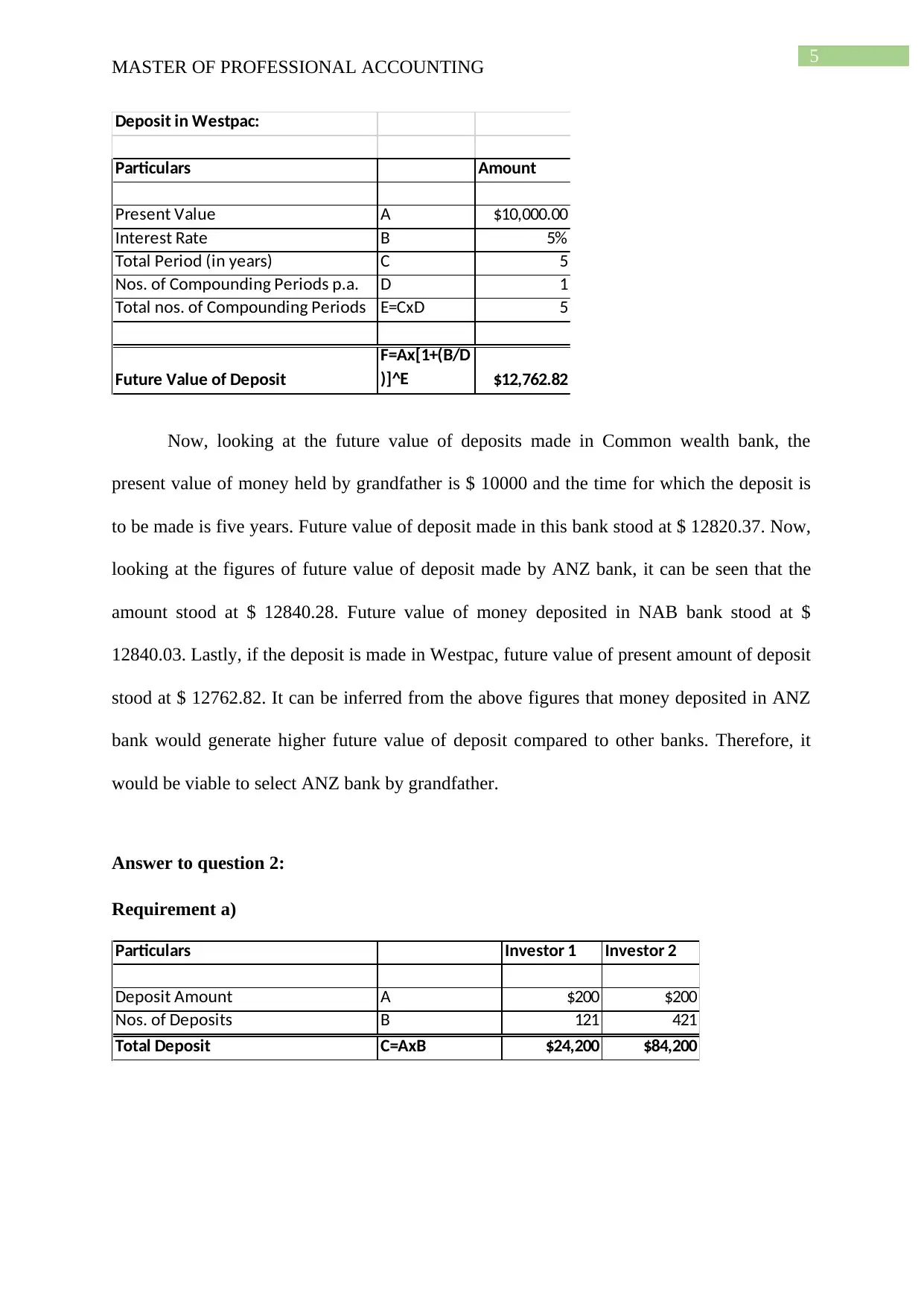
5
MASTER OF PROFESSIONAL ACCOUNTING
Deposit in Westpac:
Particulars Amount
Present Value A $10,000.00
Interest Rate B 5%
Total Period (in years) C 5
Nos. of Compounding Periods p.a. D 1
Total nos. of Compounding Periods E=CxD 5
Future Value of Deposit
F=Ax[1+(B/D
)]^E $12,762.82
Now, looking at the future value of deposits made in Common wealth bank, the
present value of money held by grandfather is $ 10000 and the time for which the deposit is
to be made is five years. Future value of deposit made in this bank stood at $ 12820.37. Now,
looking at the figures of future value of deposit made by ANZ bank, it can be seen that the
amount stood at $ 12840.28. Future value of money deposited in NAB bank stood at $
12840.03. Lastly, if the deposit is made in Westpac, future value of present amount of deposit
stood at $ 12762.82. It can be inferred from the above figures that money deposited in ANZ
bank would generate higher future value of deposit compared to other banks. Therefore, it
would be viable to select ANZ bank by grandfather.
Answer to question 2:
Requirement a)
Particulars Investor 1 Investor 2
Deposit Amount A $200 $200
Nos. of Deposits B 121 421
Total Deposit C=AxB $24,200 $84,200
MASTER OF PROFESSIONAL ACCOUNTING
Deposit in Westpac:
Particulars Amount
Present Value A $10,000.00
Interest Rate B 5%
Total Period (in years) C 5
Nos. of Compounding Periods p.a. D 1
Total nos. of Compounding Periods E=CxD 5
Future Value of Deposit
F=Ax[1+(B/D
)]^E $12,762.82
Now, looking at the future value of deposits made in Common wealth bank, the
present value of money held by grandfather is $ 10000 and the time for which the deposit is
to be made is five years. Future value of deposit made in this bank stood at $ 12820.37. Now,
looking at the figures of future value of deposit made by ANZ bank, it can be seen that the
amount stood at $ 12840.28. Future value of money deposited in NAB bank stood at $
12840.03. Lastly, if the deposit is made in Westpac, future value of present amount of deposit
stood at $ 12762.82. It can be inferred from the above figures that money deposited in ANZ
bank would generate higher future value of deposit compared to other banks. Therefore, it
would be viable to select ANZ bank by grandfather.
Answer to question 2:
Requirement a)
Particulars Investor 1 Investor 2
Deposit Amount A $200 $200
Nos. of Deposits B 121 421
Total Deposit C=AxB $24,200 $84,200
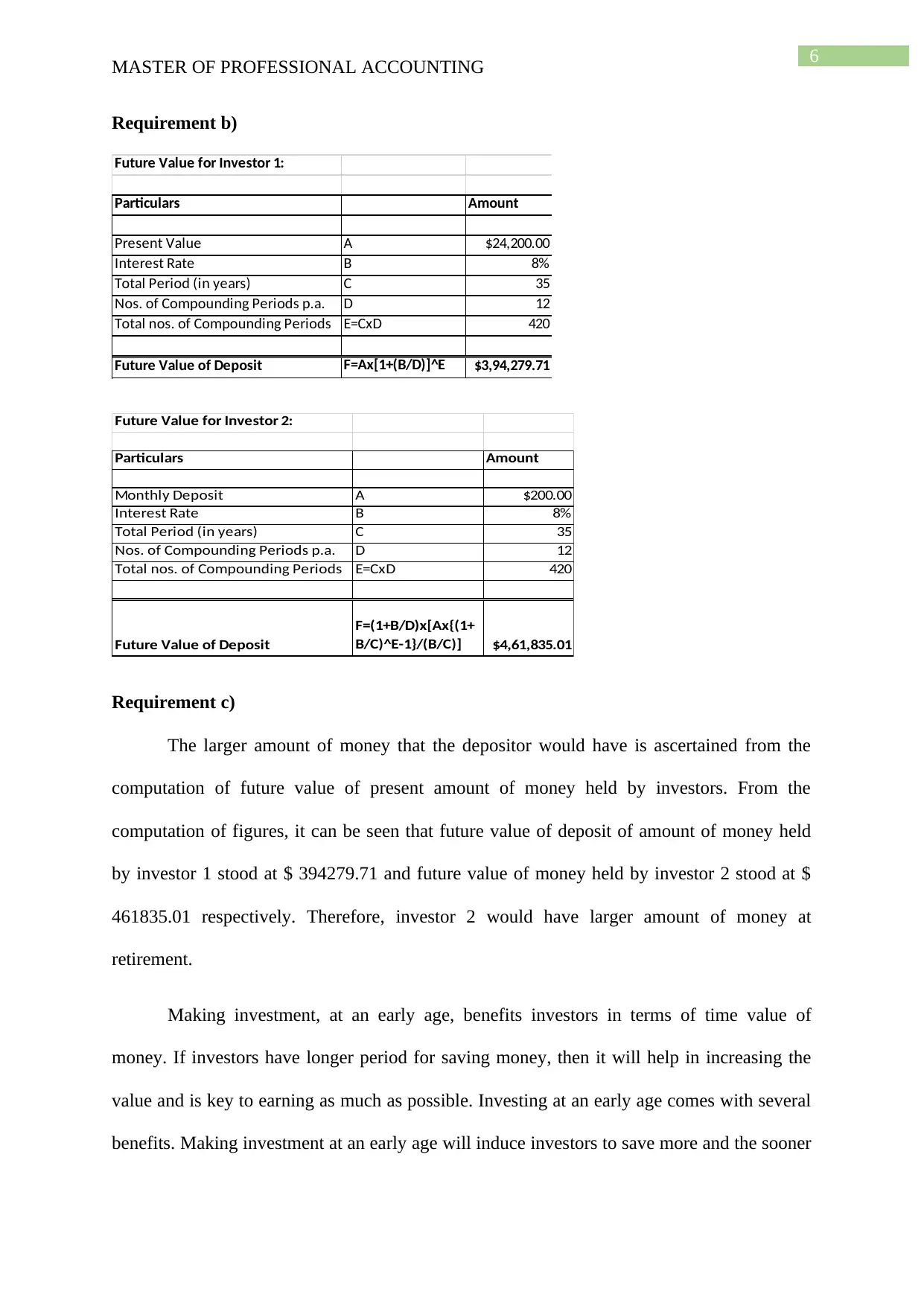
6
MASTER OF PROFESSIONAL ACCOUNTING
Requirement b)
Future Value for Investor 1:
Particulars Amount
Present Value A $24,200.00
Interest Rate B 8%
Total Period (in years) C 35
Nos. of Compounding Periods p.a. D 12
Total nos. of Compounding Periods E=CxD 420
Future Value of Deposit F=Ax[1+(B/D)]^E $3,94,279.71
Future Value for Investor 2:
Particulars Amount
Monthly Deposit A $200.00
Interest Rate B 8%
Total Period (in years) C 35
Nos. of Compounding Periods p.a. D 12
Total nos. of Compounding Periods E=CxD 420
Future Value of Deposit
F=(1+B/D)x[Ax{(1+
B/C)^E-1}/(B/C)] $4,61,835.01
Requirement c)
The larger amount of money that the depositor would have is ascertained from the
computation of future value of present amount of money held by investors. From the
computation of figures, it can be seen that future value of deposit of amount of money held
by investor 1 stood at $ 394279.71 and future value of money held by investor 2 stood at $
461835.01 respectively. Therefore, investor 2 would have larger amount of money at
retirement.
Making investment, at an early age, benefits investors in terms of time value of
money. If investors have longer period for saving money, then it will help in increasing the
value and is key to earning as much as possible. Investing at an early age comes with several
benefits. Making investment at an early age will induce investors to save more and the sooner
MASTER OF PROFESSIONAL ACCOUNTING
Requirement b)
Future Value for Investor 1:
Particulars Amount
Present Value A $24,200.00
Interest Rate B 8%
Total Period (in years) C 35
Nos. of Compounding Periods p.a. D 12
Total nos. of Compounding Periods E=CxD 420
Future Value of Deposit F=Ax[1+(B/D)]^E $3,94,279.71
Future Value for Investor 2:
Particulars Amount
Monthly Deposit A $200.00
Interest Rate B 8%
Total Period (in years) C 35
Nos. of Compounding Periods p.a. D 12
Total nos. of Compounding Periods E=CxD 420
Future Value of Deposit
F=(1+B/D)x[Ax{(1+
B/C)^E-1}/(B/C)] $4,61,835.01
Requirement c)
The larger amount of money that the depositor would have is ascertained from the
computation of future value of present amount of money held by investors. From the
computation of figures, it can be seen that future value of deposit of amount of money held
by investor 1 stood at $ 394279.71 and future value of money held by investor 2 stood at $
461835.01 respectively. Therefore, investor 2 would have larger amount of money at
retirement.
Making investment, at an early age, benefits investors in terms of time value of
money. If investors have longer period for saving money, then it will help in increasing the
value and is key to earning as much as possible. Investing at an early age comes with several
benefits. Making investment at an early age will induce investors to save more and the sooner
Paraphrase This Document
Need a fresh take? Get an instant paraphrase of this document with our AI Paraphraser
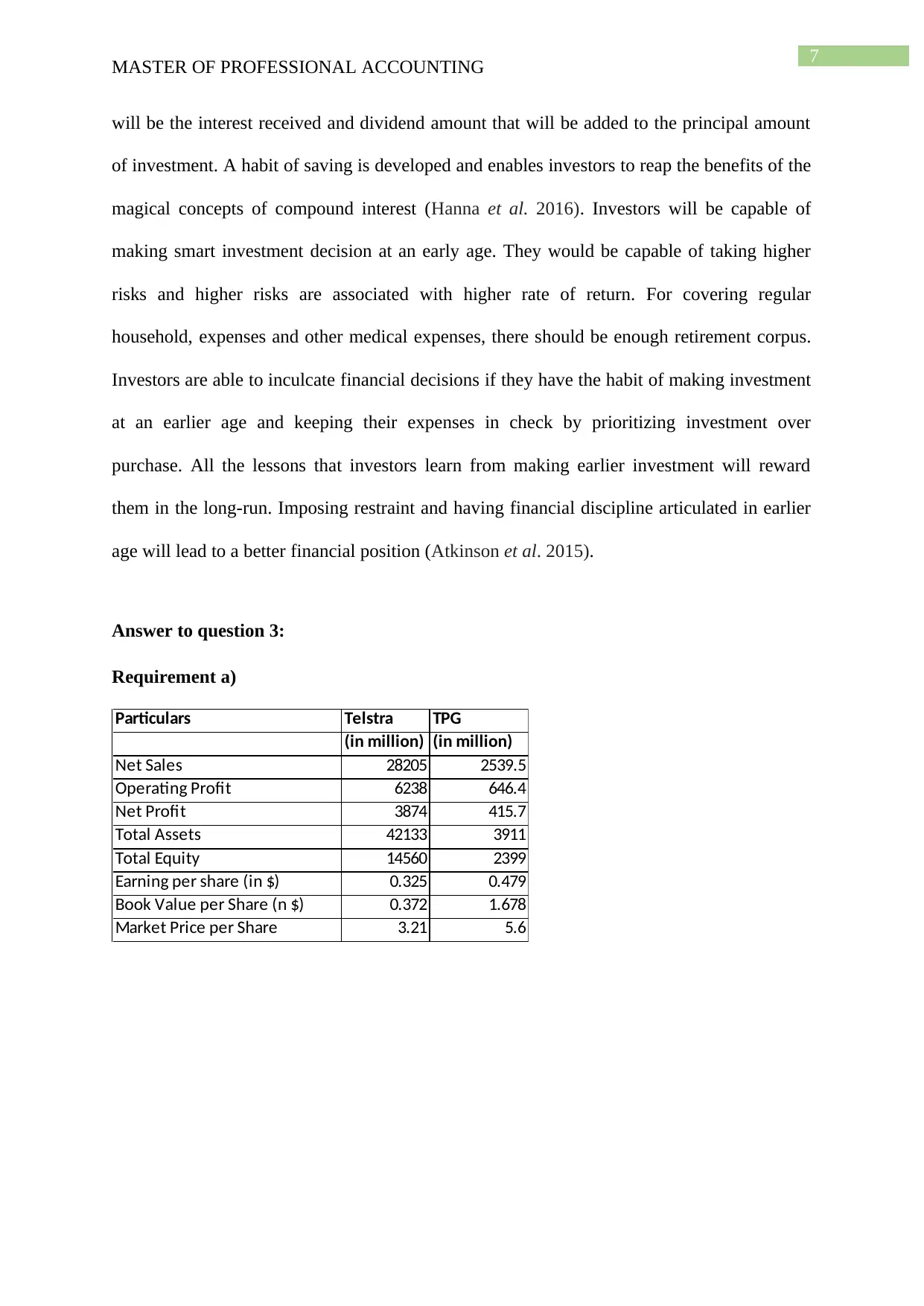
7
MASTER OF PROFESSIONAL ACCOUNTING
will be the interest received and dividend amount that will be added to the principal amount
of investment. A habit of saving is developed and enables investors to reap the benefits of the
magical concepts of compound interest (Hanna et al. 2016). Investors will be capable of
making smart investment decision at an early age. They would be capable of taking higher
risks and higher risks are associated with higher rate of return. For covering regular
household, expenses and other medical expenses, there should be enough retirement corpus.
Investors are able to inculcate financial decisions if they have the habit of making investment
at an earlier age and keeping their expenses in check by prioritizing investment over
purchase. All the lessons that investors learn from making earlier investment will reward
them in the long-run. Imposing restraint and having financial discipline articulated in earlier
age will lead to a better financial position (Atkinson et al. 2015).
Answer to question 3:
Requirement a)
Particulars Telstra TPG
(in million) (in million)
Net Sales 28205 2539.5
Operating Profit 6238 646.4
Net Profit 3874 415.7
Total Assets 42133 3911
Total Equity 14560 2399
Earning per share (in $) 0.325 0.479
Book Value per Share (n $) 0.372 1.678
Market Price per Share 3.21 5.6
MASTER OF PROFESSIONAL ACCOUNTING
will be the interest received and dividend amount that will be added to the principal amount
of investment. A habit of saving is developed and enables investors to reap the benefits of the
magical concepts of compound interest (Hanna et al. 2016). Investors will be capable of
making smart investment decision at an early age. They would be capable of taking higher
risks and higher risks are associated with higher rate of return. For covering regular
household, expenses and other medical expenses, there should be enough retirement corpus.
Investors are able to inculcate financial decisions if they have the habit of making investment
at an earlier age and keeping their expenses in check by prioritizing investment over
purchase. All the lessons that investors learn from making earlier investment will reward
them in the long-run. Imposing restraint and having financial discipline articulated in earlier
age will lead to a better financial position (Atkinson et al. 2015).
Answer to question 3:
Requirement a)
Particulars Telstra TPG
(in million) (in million)
Net Sales 28205 2539.5
Operating Profit 6238 646.4
Net Profit 3874 415.7
Total Assets 42133 3911
Total Equity 14560 2399
Earning per share (in $) 0.325 0.479
Book Value per Share (n $) 0.372 1.678
Market Price per Share 3.21 5.6
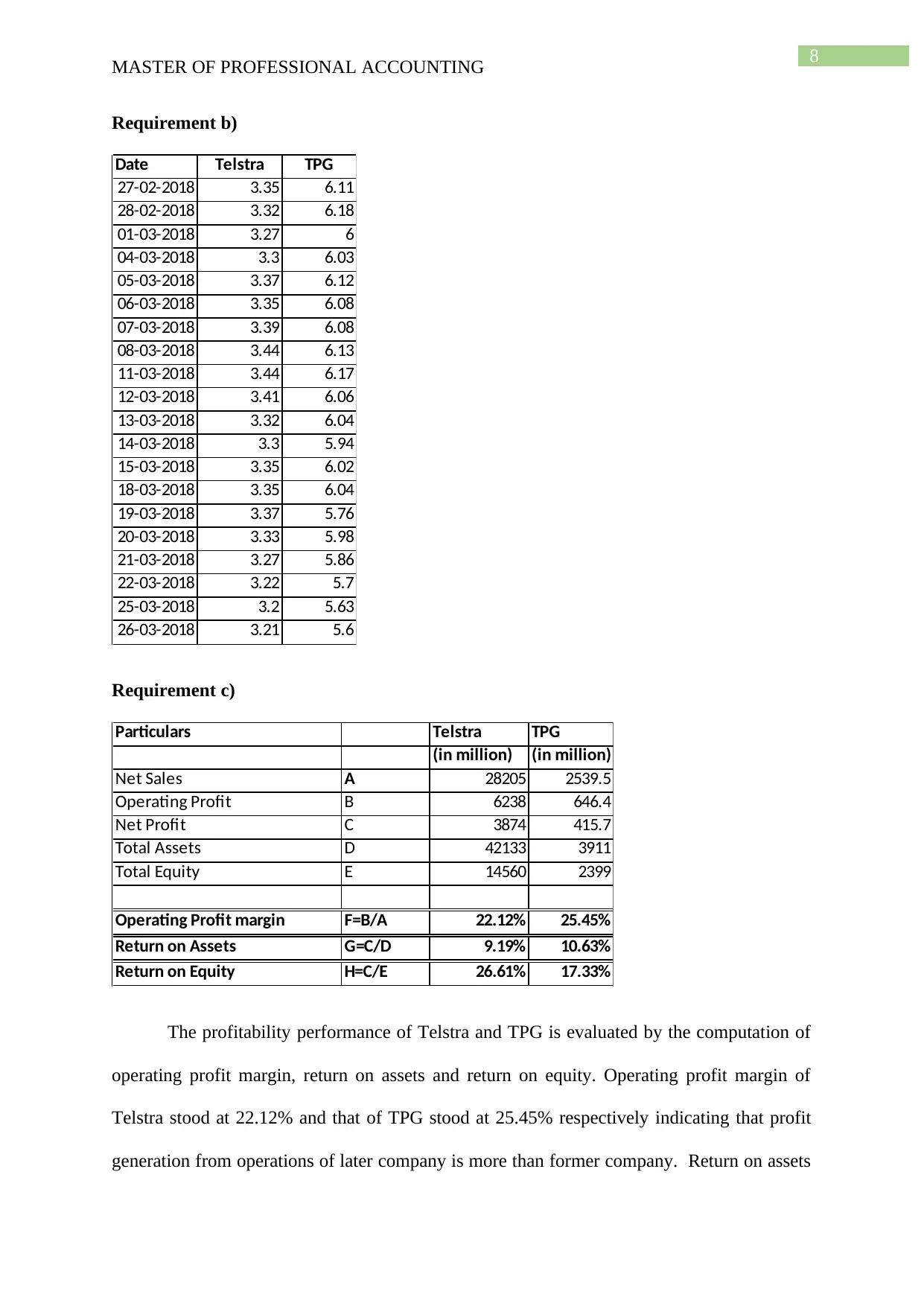
8
MASTER OF PROFESSIONAL ACCOUNTING
Requirement b)
Date Telstra TPG
27-02-2018 3.35 6.11
28-02-2018 3.32 6.18
01-03-2018 3.27 6
04-03-2018 3.3 6.03
05-03-2018 3.37 6.12
06-03-2018 3.35 6.08
07-03-2018 3.39 6.08
08-03-2018 3.44 6.13
11-03-2018 3.44 6.17
12-03-2018 3.41 6.06
13-03-2018 3.32 6.04
14-03-2018 3.3 5.94
15-03-2018 3.35 6.02
18-03-2018 3.35 6.04
19-03-2018 3.37 5.76
20-03-2018 3.33 5.98
21-03-2018 3.27 5.86
22-03-2018 3.22 5.7
25-03-2018 3.2 5.63
26-03-2018 3.21 5.6
Requirement c)
Particulars Telstra TPG
(in million) (in million)
Net Sales A 28205 2539.5
Operating Profit B 6238 646.4
Net Profit C 3874 415.7
Total Assets D 42133 3911
Total Equity E 14560 2399
Operating Profit margin F=B/A 22.12% 25.45%
Return on Assets G=C/D 9.19% 10.63%
Return on Equity H=C/E 26.61% 17.33%
The profitability performance of Telstra and TPG is evaluated by the computation of
operating profit margin, return on assets and return on equity. Operating profit margin of
Telstra stood at 22.12% and that of TPG stood at 25.45% respectively indicating that profit
generation from operations of later company is more than former company. Return on assets
MASTER OF PROFESSIONAL ACCOUNTING
Requirement b)
Date Telstra TPG
27-02-2018 3.35 6.11
28-02-2018 3.32 6.18
01-03-2018 3.27 6
04-03-2018 3.3 6.03
05-03-2018 3.37 6.12
06-03-2018 3.35 6.08
07-03-2018 3.39 6.08
08-03-2018 3.44 6.13
11-03-2018 3.44 6.17
12-03-2018 3.41 6.06
13-03-2018 3.32 6.04
14-03-2018 3.3 5.94
15-03-2018 3.35 6.02
18-03-2018 3.35 6.04
19-03-2018 3.37 5.76
20-03-2018 3.33 5.98
21-03-2018 3.27 5.86
22-03-2018 3.22 5.7
25-03-2018 3.2 5.63
26-03-2018 3.21 5.6
Requirement c)
Particulars Telstra TPG
(in million) (in million)
Net Sales A 28205 2539.5
Operating Profit B 6238 646.4
Net Profit C 3874 415.7
Total Assets D 42133 3911
Total Equity E 14560 2399
Operating Profit margin F=B/A 22.12% 25.45%
Return on Assets G=C/D 9.19% 10.63%
Return on Equity H=C/E 26.61% 17.33%
The profitability performance of Telstra and TPG is evaluated by the computation of
operating profit margin, return on assets and return on equity. Operating profit margin of
Telstra stood at 22.12% and that of TPG stood at 25.45% respectively indicating that profit
generation from operations of later company is more than former company. Return on assets
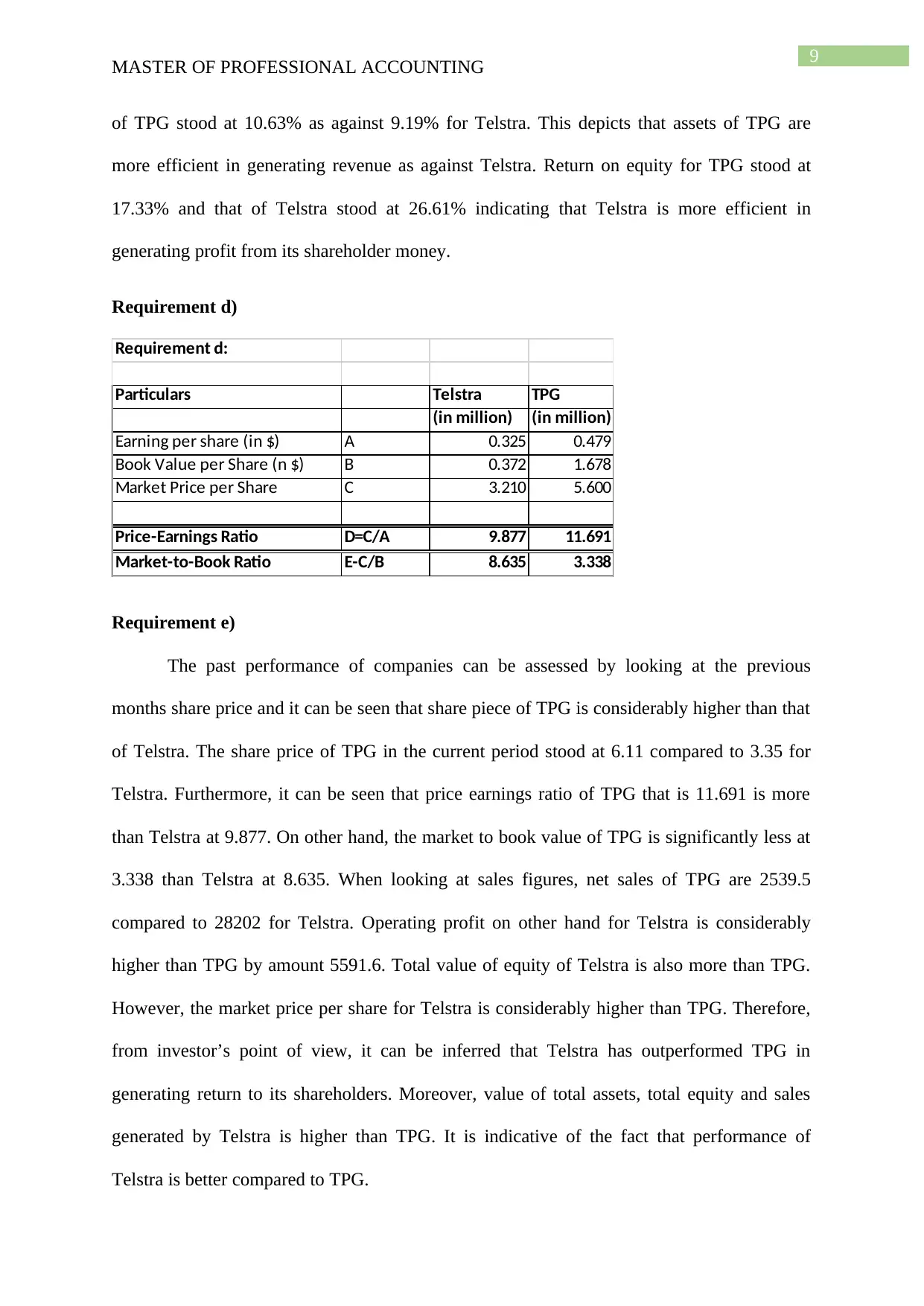
9
MASTER OF PROFESSIONAL ACCOUNTING
of TPG stood at 10.63% as against 9.19% for Telstra. This depicts that assets of TPG are
more efficient in generating revenue as against Telstra. Return on equity for TPG stood at
17.33% and that of Telstra stood at 26.61% indicating that Telstra is more efficient in
generating profit from its shareholder money.
Requirement d)
Requirement d:
Particulars Telstra TPG
(in million) (in million)
Earning per share (in $) A 0.325 0.479
Book Value per Share (n $) B 0.372 1.678
Market Price per Share C 3.210 5.600
Price-Earnings Ratio D=C/A 9.877 11.691
Market-to-Book Ratio E-C/B 8.635 3.338
Requirement e)
The past performance of companies can be assessed by looking at the previous
months share price and it can be seen that share piece of TPG is considerably higher than that
of Telstra. The share price of TPG in the current period stood at 6.11 compared to 3.35 for
Telstra. Furthermore, it can be seen that price earnings ratio of TPG that is 11.691 is more
than Telstra at 9.877. On other hand, the market to book value of TPG is significantly less at
3.338 than Telstra at 8.635. When looking at sales figures, net sales of TPG are 2539.5
compared to 28202 for Telstra. Operating profit on other hand for Telstra is considerably
higher than TPG by amount 5591.6. Total value of equity of Telstra is also more than TPG.
However, the market price per share for Telstra is considerably higher than TPG. Therefore,
from investor’s point of view, it can be inferred that Telstra has outperformed TPG in
generating return to its shareholders. Moreover, value of total assets, total equity and sales
generated by Telstra is higher than TPG. It is indicative of the fact that performance of
Telstra is better compared to TPG.
MASTER OF PROFESSIONAL ACCOUNTING
of TPG stood at 10.63% as against 9.19% for Telstra. This depicts that assets of TPG are
more efficient in generating revenue as against Telstra. Return on equity for TPG stood at
17.33% and that of Telstra stood at 26.61% indicating that Telstra is more efficient in
generating profit from its shareholder money.
Requirement d)
Requirement d:
Particulars Telstra TPG
(in million) (in million)
Earning per share (in $) A 0.325 0.479
Book Value per Share (n $) B 0.372 1.678
Market Price per Share C 3.210 5.600
Price-Earnings Ratio D=C/A 9.877 11.691
Market-to-Book Ratio E-C/B 8.635 3.338
Requirement e)
The past performance of companies can be assessed by looking at the previous
months share price and it can be seen that share piece of TPG is considerably higher than that
of Telstra. The share price of TPG in the current period stood at 6.11 compared to 3.35 for
Telstra. Furthermore, it can be seen that price earnings ratio of TPG that is 11.691 is more
than Telstra at 9.877. On other hand, the market to book value of TPG is significantly less at
3.338 than Telstra at 8.635. When looking at sales figures, net sales of TPG are 2539.5
compared to 28202 for Telstra. Operating profit on other hand for Telstra is considerably
higher than TPG by amount 5591.6. Total value of equity of Telstra is also more than TPG.
However, the market price per share for Telstra is considerably higher than TPG. Therefore,
from investor’s point of view, it can be inferred that Telstra has outperformed TPG in
generating return to its shareholders. Moreover, value of total assets, total equity and sales
generated by Telstra is higher than TPG. It is indicative of the fact that performance of
Telstra is better compared to TPG.
Secure Best Marks with AI Grader
Need help grading? Try our AI Grader for instant feedback on your assignments.
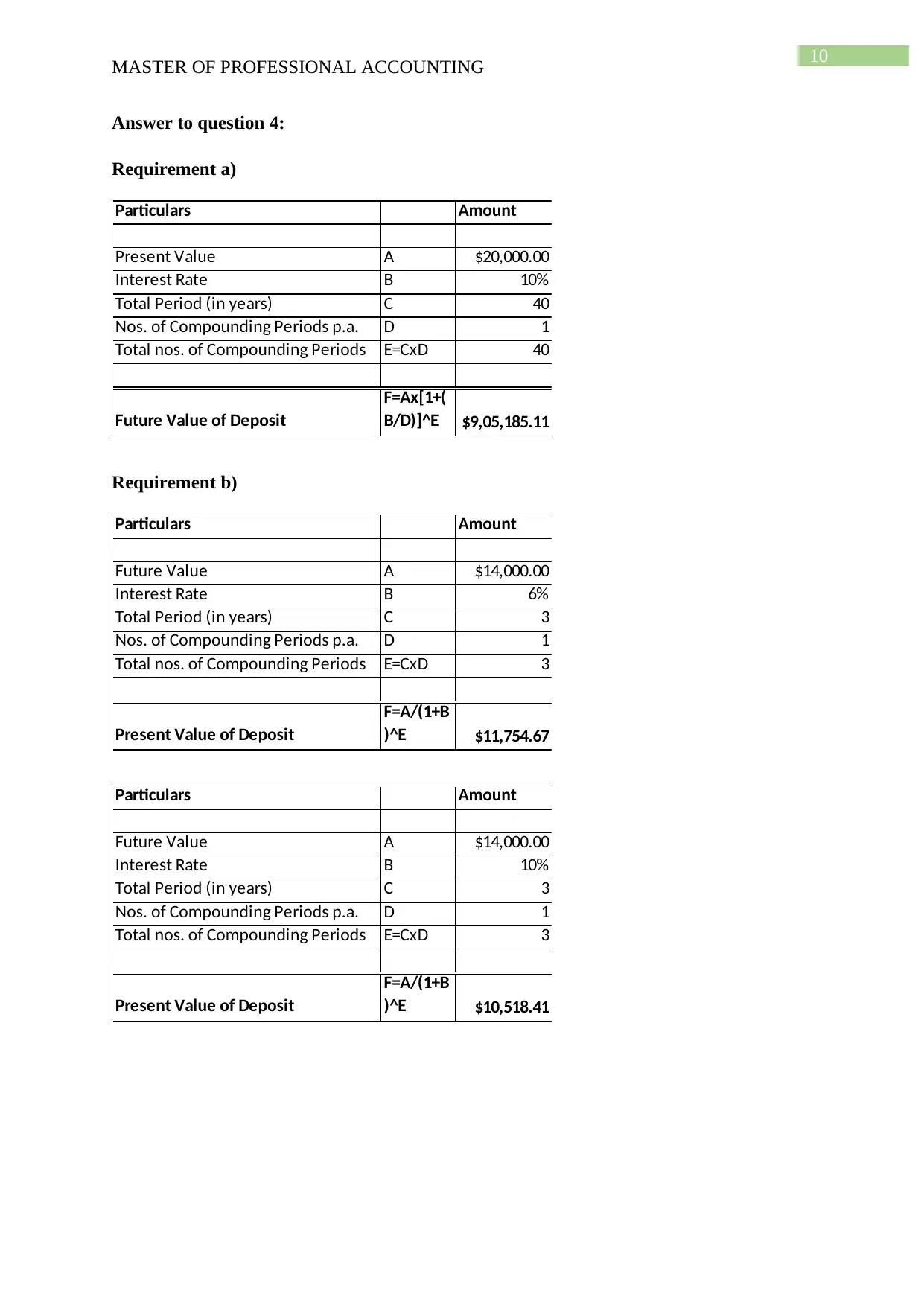
10
MASTER OF PROFESSIONAL ACCOUNTING
Answer to question 4:
Requirement a)
Particulars Amount
Present Value A $20,000.00
Interest Rate B 10%
Total Period (in years) C 40
Nos. of Compounding Periods p.a. D 1
Total nos. of Compounding Periods E=CxD 40
Future Value of Deposit
F=Ax[1+(
B/D)]^E $9,05,185.11
Requirement b)
Particulars Amount
Future Value A $14,000.00
Interest Rate B 6%
Total Period (in years) C 3
Nos. of Compounding Periods p.a. D 1
Total nos. of Compounding Periods E=CxD 3
Present Value of Deposit
F=A/(1+B
)^E $11,754.67
Particulars Amount
Future Value A $14,000.00
Interest Rate B 10%
Total Period (in years) C 3
Nos. of Compounding Periods p.a. D 1
Total nos. of Compounding Periods E=CxD 3
Present Value of Deposit
F=A/(1+B
)^E $10,518.41
MASTER OF PROFESSIONAL ACCOUNTING
Answer to question 4:
Requirement a)
Particulars Amount
Present Value A $20,000.00
Interest Rate B 10%
Total Period (in years) C 40
Nos. of Compounding Periods p.a. D 1
Total nos. of Compounding Periods E=CxD 40
Future Value of Deposit
F=Ax[1+(
B/D)]^E $9,05,185.11
Requirement b)
Particulars Amount
Future Value A $14,000.00
Interest Rate B 6%
Total Period (in years) C 3
Nos. of Compounding Periods p.a. D 1
Total nos. of Compounding Periods E=CxD 3
Present Value of Deposit
F=A/(1+B
)^E $11,754.67
Particulars Amount
Future Value A $14,000.00
Interest Rate B 10%
Total Period (in years) C 3
Nos. of Compounding Periods p.a. D 1
Total nos. of Compounding Periods E=CxD 3
Present Value of Deposit
F=A/(1+B
)^E $10,518.41
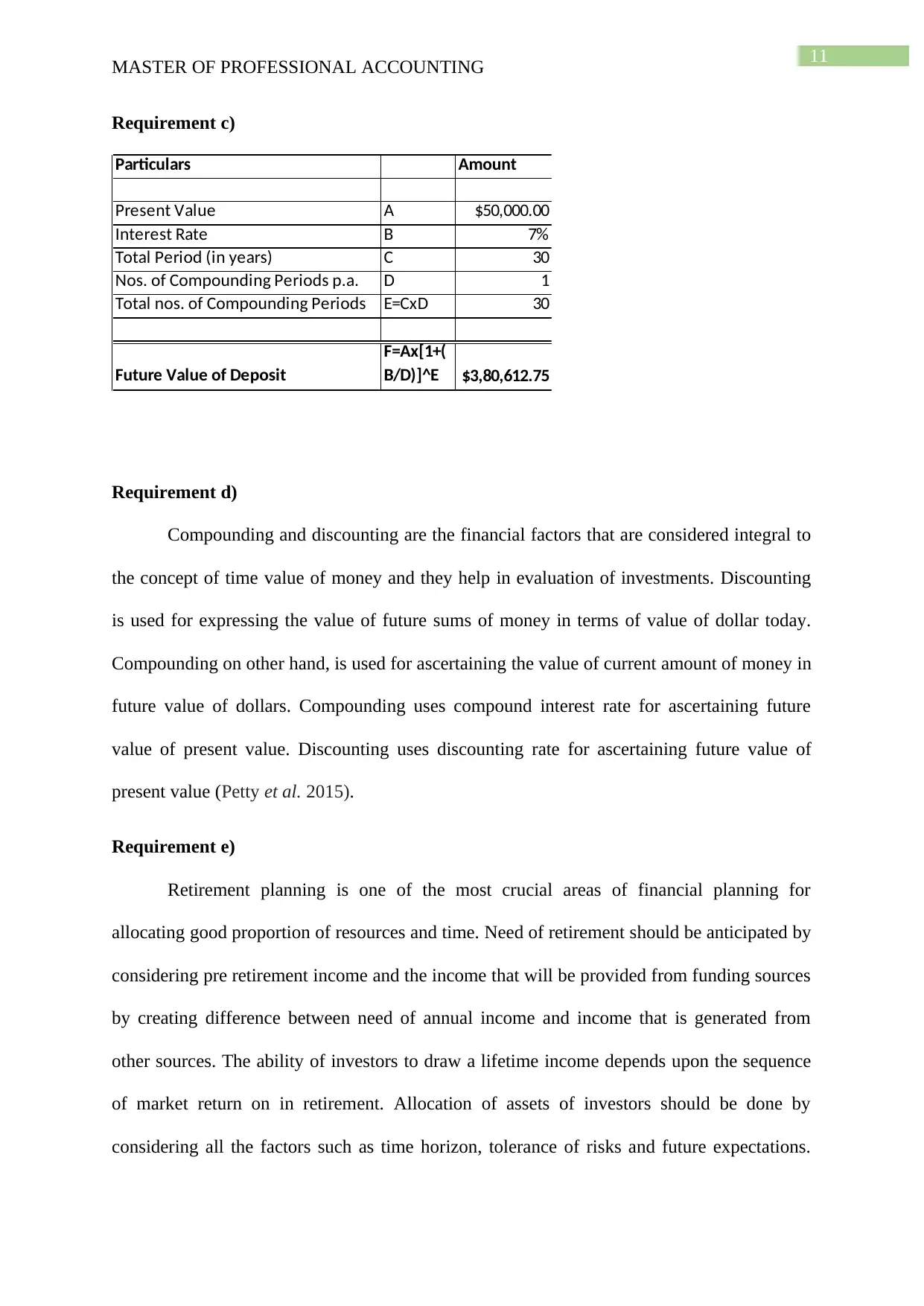
11
MASTER OF PROFESSIONAL ACCOUNTING
Requirement c)
Particulars Amount
Present Value A $50,000.00
Interest Rate B 7%
Total Period (in years) C 30
Nos. of Compounding Periods p.a. D 1
Total nos. of Compounding Periods E=CxD 30
Future Value of Deposit
F=Ax[1+(
B/D)]^E $3,80,612.75
Requirement d)
Compounding and discounting are the financial factors that are considered integral to
the concept of time value of money and they help in evaluation of investments. Discounting
is used for expressing the value of future sums of money in terms of value of dollar today.
Compounding on other hand, is used for ascertaining the value of current amount of money in
future value of dollars. Compounding uses compound interest rate for ascertaining future
value of present value. Discounting uses discounting rate for ascertaining future value of
present value (Petty et al. 2015).
Requirement e)
Retirement planning is one of the most crucial areas of financial planning for
allocating good proportion of resources and time. Need of retirement should be anticipated by
considering pre retirement income and the income that will be provided from funding sources
by creating difference between need of annual income and income that is generated from
other sources. The ability of investors to draw a lifetime income depends upon the sequence
of market return on in retirement. Allocation of assets of investors should be done by
considering all the factors such as time horizon, tolerance of risks and future expectations.
MASTER OF PROFESSIONAL ACCOUNTING
Requirement c)
Particulars Amount
Present Value A $50,000.00
Interest Rate B 7%
Total Period (in years) C 30
Nos. of Compounding Periods p.a. D 1
Total nos. of Compounding Periods E=CxD 30
Future Value of Deposit
F=Ax[1+(
B/D)]^E $3,80,612.75
Requirement d)
Compounding and discounting are the financial factors that are considered integral to
the concept of time value of money and they help in evaluation of investments. Discounting
is used for expressing the value of future sums of money in terms of value of dollar today.
Compounding on other hand, is used for ascertaining the value of current amount of money in
future value of dollars. Compounding uses compound interest rate for ascertaining future
value of present value. Discounting uses discounting rate for ascertaining future value of
present value (Petty et al. 2015).
Requirement e)
Retirement planning is one of the most crucial areas of financial planning for
allocating good proportion of resources and time. Need of retirement should be anticipated by
considering pre retirement income and the income that will be provided from funding sources
by creating difference between need of annual income and income that is generated from
other sources. The ability of investors to draw a lifetime income depends upon the sequence
of market return on in retirement. Allocation of assets of investors should be done by
considering all the factors such as time horizon, tolerance of risks and future expectations.
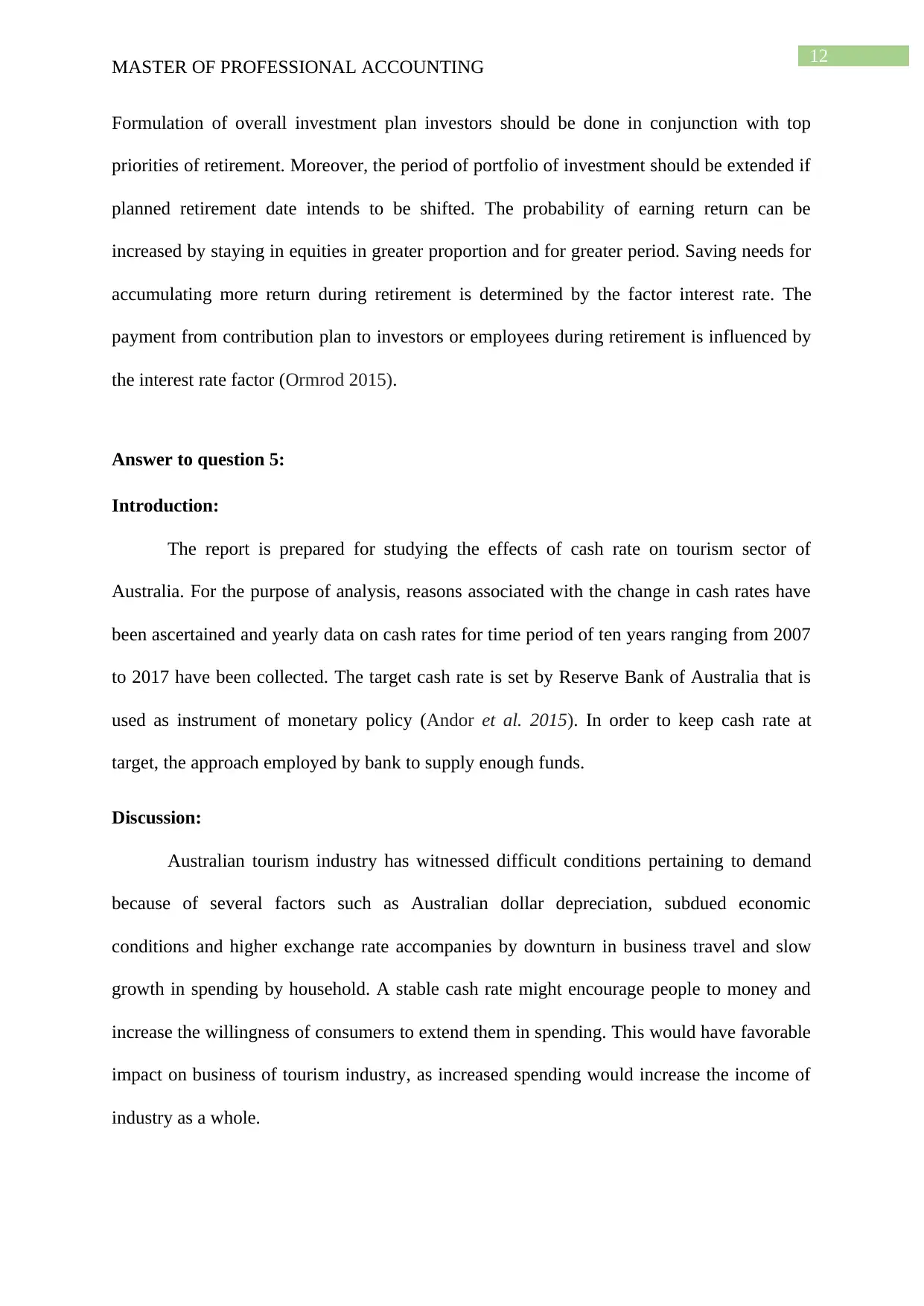
12
MASTER OF PROFESSIONAL ACCOUNTING
Formulation of overall investment plan investors should be done in conjunction with top
priorities of retirement. Moreover, the period of portfolio of investment should be extended if
planned retirement date intends to be shifted. The probability of earning return can be
increased by staying in equities in greater proportion and for greater period. Saving needs for
accumulating more return during retirement is determined by the factor interest rate. The
payment from contribution plan to investors or employees during retirement is influenced by
the interest rate factor (Ormrod 2015).
Answer to question 5:
Introduction:
The report is prepared for studying the effects of cash rate on tourism sector of
Australia. For the purpose of analysis, reasons associated with the change in cash rates have
been ascertained and yearly data on cash rates for time period of ten years ranging from 2007
to 2017 have been collected. The target cash rate is set by Reserve Bank of Australia that is
used as instrument of monetary policy (Andor et al. 2015). In order to keep cash rate at
target, the approach employed by bank to supply enough funds.
Discussion:
Australian tourism industry has witnessed difficult conditions pertaining to demand
because of several factors such as Australian dollar depreciation, subdued economic
conditions and higher exchange rate accompanies by downturn in business travel and slow
growth in spending by household. A stable cash rate might encourage people to money and
increase the willingness of consumers to extend them in spending. This would have favorable
impact on business of tourism industry, as increased spending would increase the income of
industry as a whole.
MASTER OF PROFESSIONAL ACCOUNTING
Formulation of overall investment plan investors should be done in conjunction with top
priorities of retirement. Moreover, the period of portfolio of investment should be extended if
planned retirement date intends to be shifted. The probability of earning return can be
increased by staying in equities in greater proportion and for greater period. Saving needs for
accumulating more return during retirement is determined by the factor interest rate. The
payment from contribution plan to investors or employees during retirement is influenced by
the interest rate factor (Ormrod 2015).
Answer to question 5:
Introduction:
The report is prepared for studying the effects of cash rate on tourism sector of
Australia. For the purpose of analysis, reasons associated with the change in cash rates have
been ascertained and yearly data on cash rates for time period of ten years ranging from 2007
to 2017 have been collected. The target cash rate is set by Reserve Bank of Australia that is
used as instrument of monetary policy (Andor et al. 2015). In order to keep cash rate at
target, the approach employed by bank to supply enough funds.
Discussion:
Australian tourism industry has witnessed difficult conditions pertaining to demand
because of several factors such as Australian dollar depreciation, subdued economic
conditions and higher exchange rate accompanies by downturn in business travel and slow
growth in spending by household. A stable cash rate might encourage people to money and
increase the willingness of consumers to extend them in spending. This would have favorable
impact on business of tourism industry, as increased spending would increase the income of
industry as a whole.
Paraphrase This Document
Need a fresh take? Get an instant paraphrase of this document with our AI Paraphraser
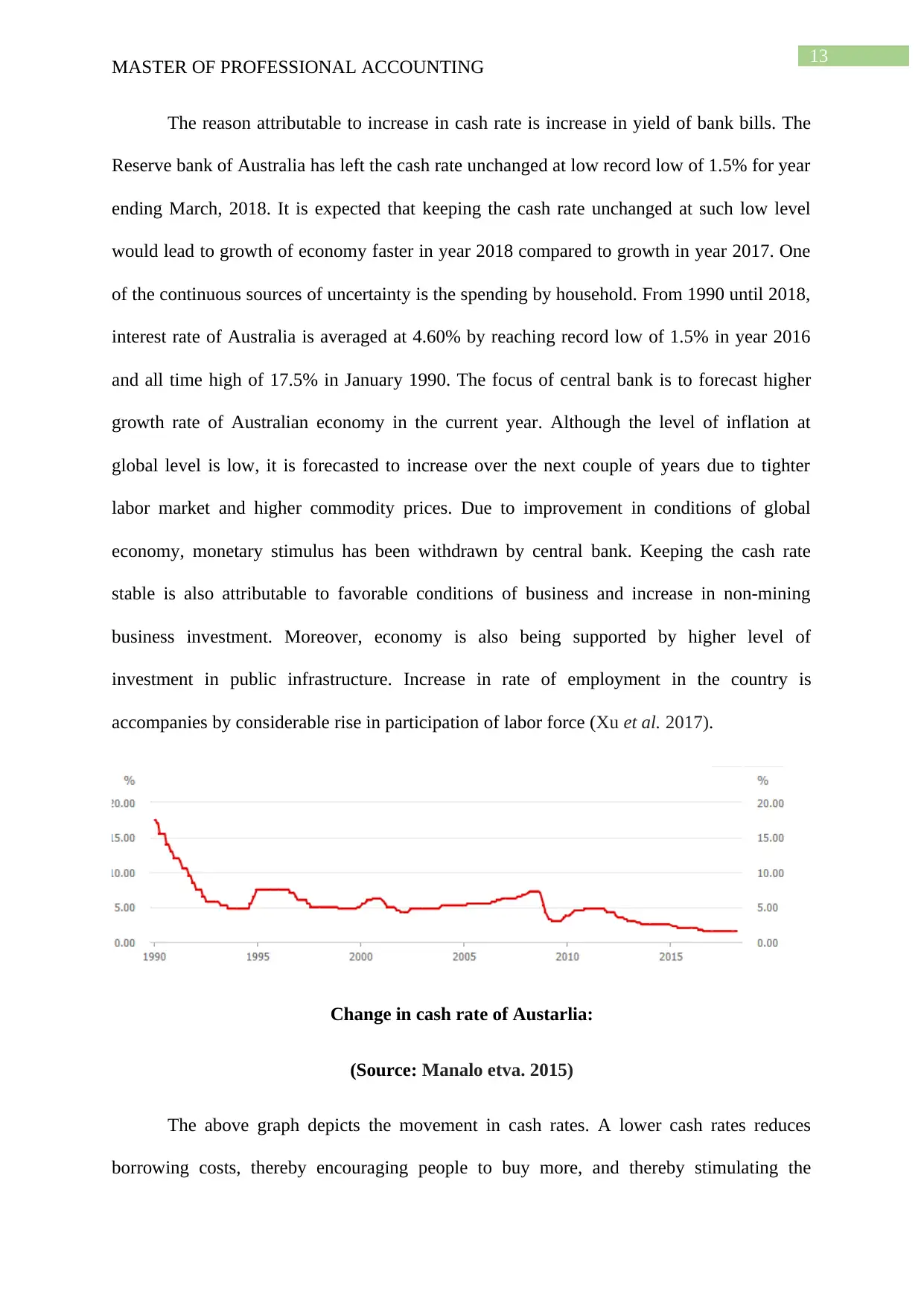
13
MASTER OF PROFESSIONAL ACCOUNTING
The reason attributable to increase in cash rate is increase in yield of bank bills. The
Reserve bank of Australia has left the cash rate unchanged at low record low of 1.5% for year
ending March, 2018. It is expected that keeping the cash rate unchanged at such low level
would lead to growth of economy faster in year 2018 compared to growth in year 2017. One
of the continuous sources of uncertainty is the spending by household. From 1990 until 2018,
interest rate of Australia is averaged at 4.60% by reaching record low of 1.5% in year 2016
and all time high of 17.5% in January 1990. The focus of central bank is to forecast higher
growth rate of Australian economy in the current year. Although the level of inflation at
global level is low, it is forecasted to increase over the next couple of years due to tighter
labor market and higher commodity prices. Due to improvement in conditions of global
economy, monetary stimulus has been withdrawn by central bank. Keeping the cash rate
stable is also attributable to favorable conditions of business and increase in non-mining
business investment. Moreover, economy is also being supported by higher level of
investment in public infrastructure. Increase in rate of employment in the country is
accompanies by considerable rise in participation of labor force (Xu et al. 2017).
Change in cash rate of Austarlia:
(Source: Manalo etva. 2015)
The above graph depicts the movement in cash rates. A lower cash rates reduces
borrowing costs, thereby encouraging people to buy more, and thereby stimulating the
MASTER OF PROFESSIONAL ACCOUNTING
The reason attributable to increase in cash rate is increase in yield of bank bills. The
Reserve bank of Australia has left the cash rate unchanged at low record low of 1.5% for year
ending March, 2018. It is expected that keeping the cash rate unchanged at such low level
would lead to growth of economy faster in year 2018 compared to growth in year 2017. One
of the continuous sources of uncertainty is the spending by household. From 1990 until 2018,
interest rate of Australia is averaged at 4.60% by reaching record low of 1.5% in year 2016
and all time high of 17.5% in January 1990. The focus of central bank is to forecast higher
growth rate of Australian economy in the current year. Although the level of inflation at
global level is low, it is forecasted to increase over the next couple of years due to tighter
labor market and higher commodity prices. Due to improvement in conditions of global
economy, monetary stimulus has been withdrawn by central bank. Keeping the cash rate
stable is also attributable to favorable conditions of business and increase in non-mining
business investment. Moreover, economy is also being supported by higher level of
investment in public infrastructure. Increase in rate of employment in the country is
accompanies by considerable rise in participation of labor force (Xu et al. 2017).
Change in cash rate of Austarlia:
(Source: Manalo etva. 2015)
The above graph depicts the movement in cash rates. A lower cash rates reduces
borrowing costs, thereby encouraging people to buy more, and thereby stimulating the
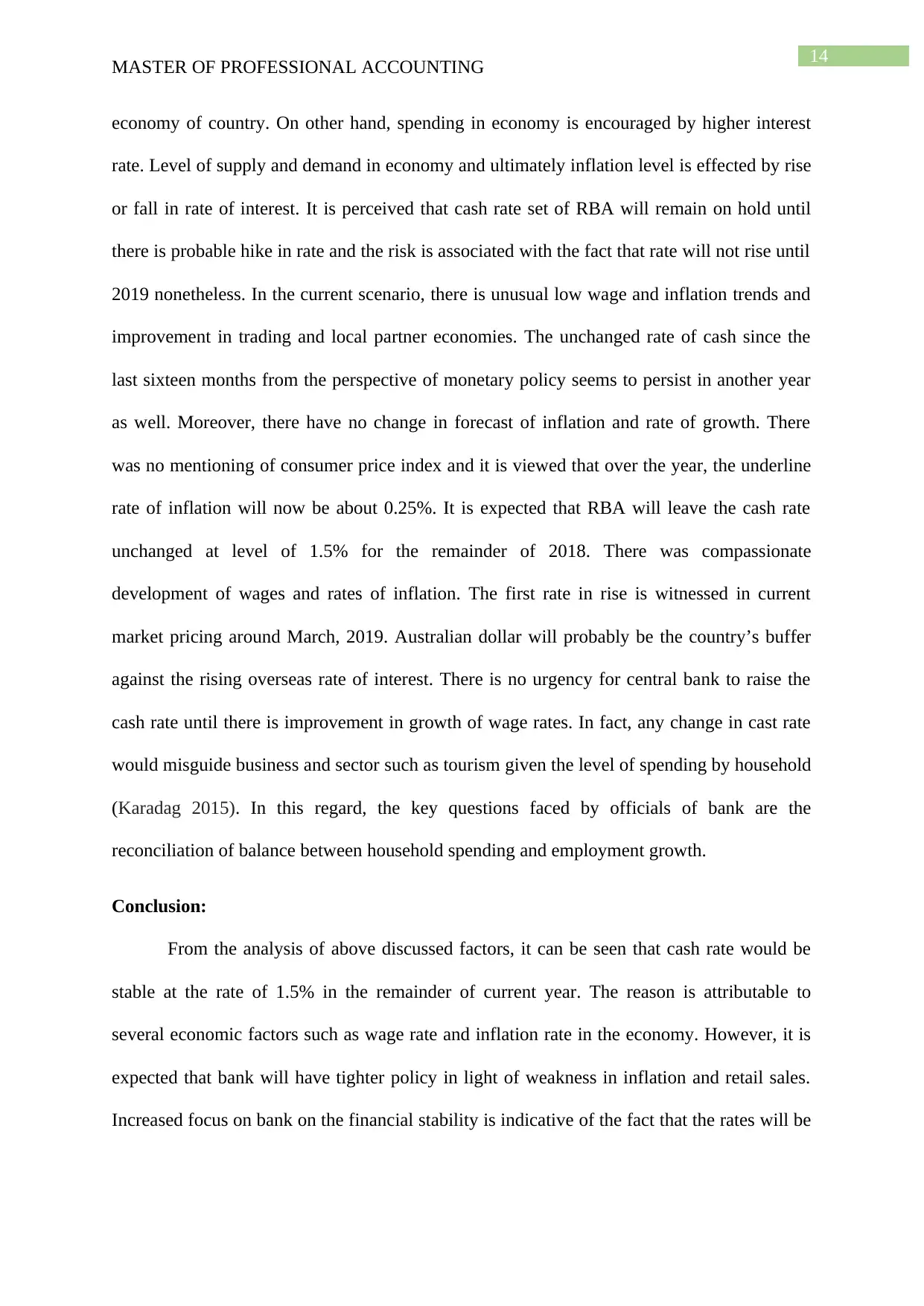
14
MASTER OF PROFESSIONAL ACCOUNTING
economy of country. On other hand, spending in economy is encouraged by higher interest
rate. Level of supply and demand in economy and ultimately inflation level is effected by rise
or fall in rate of interest. It is perceived that cash rate set of RBA will remain on hold until
there is probable hike in rate and the risk is associated with the fact that rate will not rise until
2019 nonetheless. In the current scenario, there is unusual low wage and inflation trends and
improvement in trading and local partner economies. The unchanged rate of cash since the
last sixteen months from the perspective of monetary policy seems to persist in another year
as well. Moreover, there have no change in forecast of inflation and rate of growth. There
was no mentioning of consumer price index and it is viewed that over the year, the underline
rate of inflation will now be about 0.25%. It is expected that RBA will leave the cash rate
unchanged at level of 1.5% for the remainder of 2018. There was compassionate
development of wages and rates of inflation. The first rate in rise is witnessed in current
market pricing around March, 2019. Australian dollar will probably be the country’s buffer
against the rising overseas rate of interest. There is no urgency for central bank to raise the
cash rate until there is improvement in growth of wage rates. In fact, any change in cast rate
would misguide business and sector such as tourism given the level of spending by household
(Karadag 2015). In this regard, the key questions faced by officials of bank are the
reconciliation of balance between household spending and employment growth.
Conclusion:
From the analysis of above discussed factors, it can be seen that cash rate would be
stable at the rate of 1.5% in the remainder of current year. The reason is attributable to
several economic factors such as wage rate and inflation rate in the economy. However, it is
expected that bank will have tighter policy in light of weakness in inflation and retail sales.
Increased focus on bank on the financial stability is indicative of the fact that the rates will be
MASTER OF PROFESSIONAL ACCOUNTING
economy of country. On other hand, spending in economy is encouraged by higher interest
rate. Level of supply and demand in economy and ultimately inflation level is effected by rise
or fall in rate of interest. It is perceived that cash rate set of RBA will remain on hold until
there is probable hike in rate and the risk is associated with the fact that rate will not rise until
2019 nonetheless. In the current scenario, there is unusual low wage and inflation trends and
improvement in trading and local partner economies. The unchanged rate of cash since the
last sixteen months from the perspective of monetary policy seems to persist in another year
as well. Moreover, there have no change in forecast of inflation and rate of growth. There
was no mentioning of consumer price index and it is viewed that over the year, the underline
rate of inflation will now be about 0.25%. It is expected that RBA will leave the cash rate
unchanged at level of 1.5% for the remainder of 2018. There was compassionate
development of wages and rates of inflation. The first rate in rise is witnessed in current
market pricing around March, 2019. Australian dollar will probably be the country’s buffer
against the rising overseas rate of interest. There is no urgency for central bank to raise the
cash rate until there is improvement in growth of wage rates. In fact, any change in cast rate
would misguide business and sector such as tourism given the level of spending by household
(Karadag 2015). In this regard, the key questions faced by officials of bank are the
reconciliation of balance between household spending and employment growth.
Conclusion:
From the analysis of above discussed factors, it can be seen that cash rate would be
stable at the rate of 1.5% in the remainder of current year. The reason is attributable to
several economic factors such as wage rate and inflation rate in the economy. However, it is
expected that bank will have tighter policy in light of weakness in inflation and retail sales.
Increased focus on bank on the financial stability is indicative of the fact that the rates will be
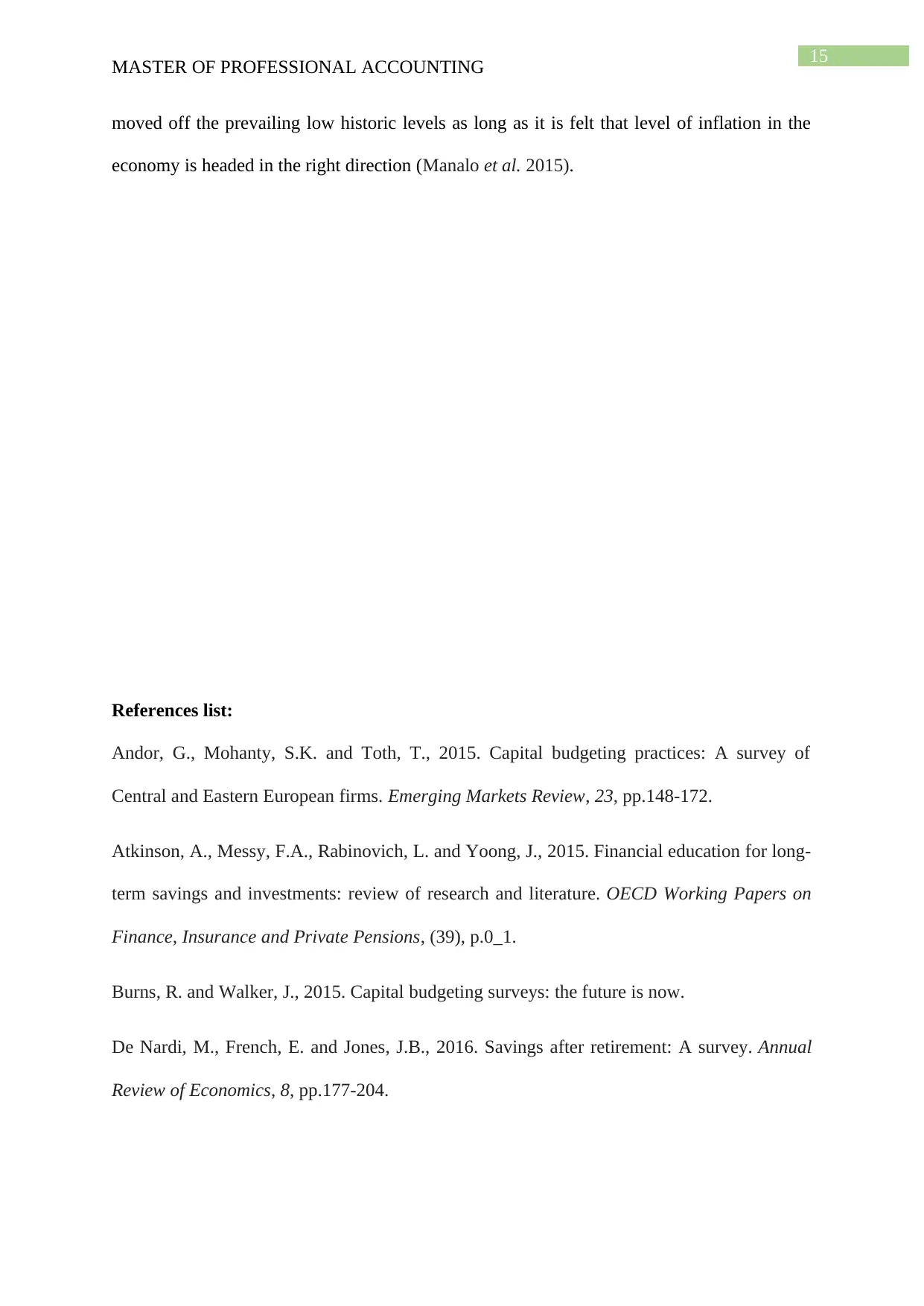
15
MASTER OF PROFESSIONAL ACCOUNTING
moved off the prevailing low historic levels as long as it is felt that level of inflation in the
economy is headed in the right direction (Manalo et al. 2015).
References list:
Andor, G., Mohanty, S.K. and Toth, T., 2015. Capital budgeting practices: A survey of
Central and Eastern European firms. Emerging Markets Review, 23, pp.148-172.
Atkinson, A., Messy, F.A., Rabinovich, L. and Yoong, J., 2015. Financial education for long-
term savings and investments: review of research and literature. OECD Working Papers on
Finance, Insurance and Private Pensions, (39), p.0_1.
Burns, R. and Walker, J., 2015. Capital budgeting surveys: the future is now.
De Nardi, M., French, E. and Jones, J.B., 2016. Savings after retirement: A survey. Annual
Review of Economics, 8, pp.177-204.
MASTER OF PROFESSIONAL ACCOUNTING
moved off the prevailing low historic levels as long as it is felt that level of inflation in the
economy is headed in the right direction (Manalo et al. 2015).
References list:
Andor, G., Mohanty, S.K. and Toth, T., 2015. Capital budgeting practices: A survey of
Central and Eastern European firms. Emerging Markets Review, 23, pp.148-172.
Atkinson, A., Messy, F.A., Rabinovich, L. and Yoong, J., 2015. Financial education for long-
term savings and investments: review of research and literature. OECD Working Papers on
Finance, Insurance and Private Pensions, (39), p.0_1.
Burns, R. and Walker, J., 2015. Capital budgeting surveys: the future is now.
De Nardi, M., French, E. and Jones, J.B., 2016. Savings after retirement: A survey. Annual
Review of Economics, 8, pp.177-204.
Secure Best Marks with AI Grader
Need help grading? Try our AI Grader for instant feedback on your assignments.
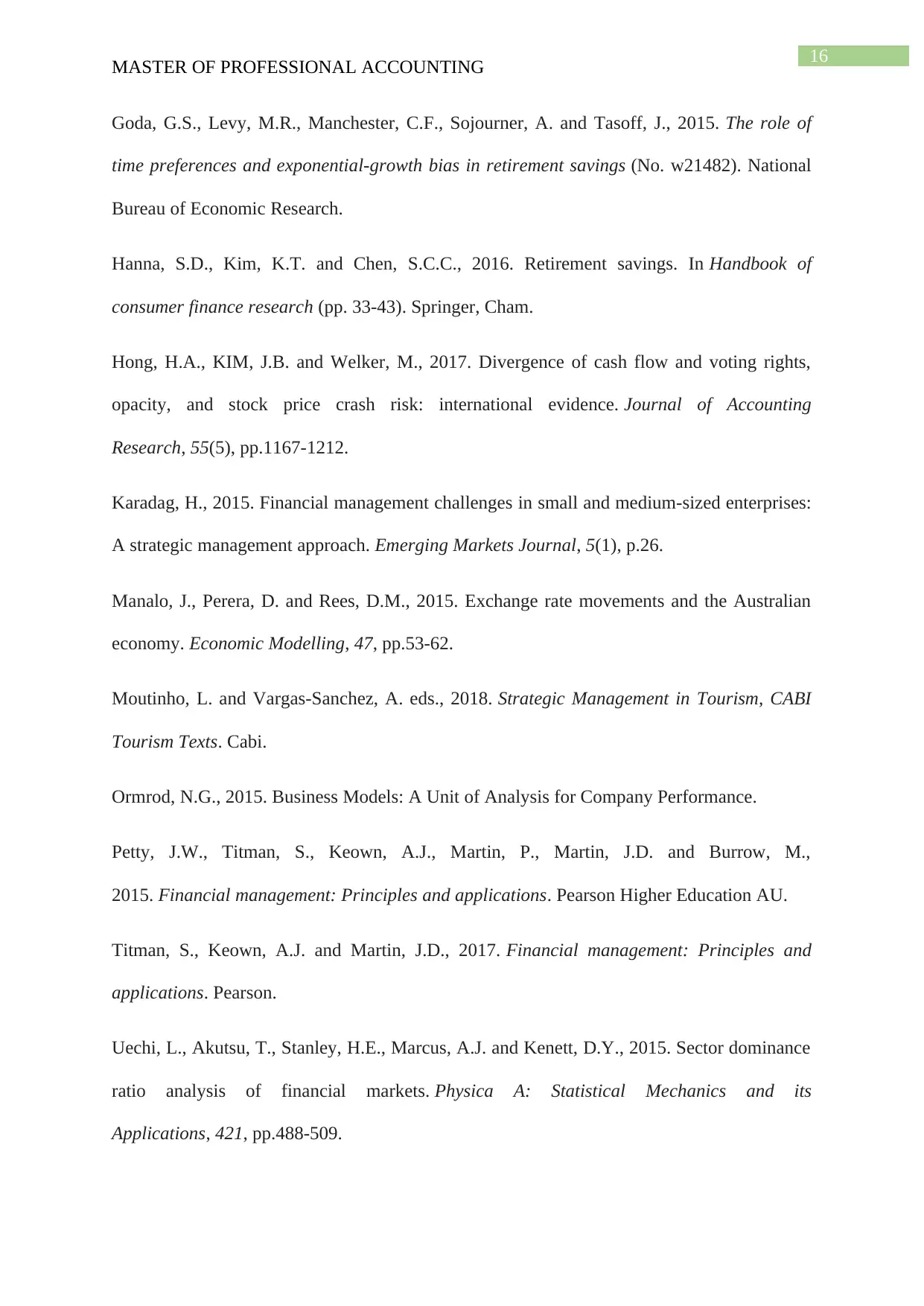
16
MASTER OF PROFESSIONAL ACCOUNTING
Goda, G.S., Levy, M.R., Manchester, C.F., Sojourner, A. and Tasoff, J., 2015. The role of
time preferences and exponential-growth bias in retirement savings (No. w21482). National
Bureau of Economic Research.
Hanna, S.D., Kim, K.T. and Chen, S.C.C., 2016. Retirement savings. In Handbook of
consumer finance research (pp. 33-43). Springer, Cham.
Hong, H.A., KIM, J.B. and Welker, M., 2017. Divergence of cash flow and voting rights,
opacity, and stock price crash risk: international evidence. Journal of Accounting
Research, 55(5), pp.1167-1212.
Karadag, H., 2015. Financial management challenges in small and medium-sized enterprises:
A strategic management approach. Emerging Markets Journal, 5(1), p.26.
Manalo, J., Perera, D. and Rees, D.M., 2015. Exchange rate movements and the Australian
economy. Economic Modelling, 47, pp.53-62.
Moutinho, L. and Vargas-Sanchez, A. eds., 2018. Strategic Management in Tourism, CABI
Tourism Texts. Cabi.
Ormrod, N.G., 2015. Business Models: A Unit of Analysis for Company Performance.
Petty, J.W., Titman, S., Keown, A.J., Martin, P., Martin, J.D. and Burrow, M.,
2015. Financial management: Principles and applications. Pearson Higher Education AU.
Titman, S., Keown, A.J. and Martin, J.D., 2017. Financial management: Principles and
applications. Pearson.
Uechi, L., Akutsu, T., Stanley, H.E., Marcus, A.J. and Kenett, D.Y., 2015. Sector dominance
ratio analysis of financial markets. Physica A: Statistical Mechanics and its
Applications, 421, pp.488-509.
MASTER OF PROFESSIONAL ACCOUNTING
Goda, G.S., Levy, M.R., Manchester, C.F., Sojourner, A. and Tasoff, J., 2015. The role of
time preferences and exponential-growth bias in retirement savings (No. w21482). National
Bureau of Economic Research.
Hanna, S.D., Kim, K.T. and Chen, S.C.C., 2016. Retirement savings. In Handbook of
consumer finance research (pp. 33-43). Springer, Cham.
Hong, H.A., KIM, J.B. and Welker, M., 2017. Divergence of cash flow and voting rights,
opacity, and stock price crash risk: international evidence. Journal of Accounting
Research, 55(5), pp.1167-1212.
Karadag, H., 2015. Financial management challenges in small and medium-sized enterprises:
A strategic management approach. Emerging Markets Journal, 5(1), p.26.
Manalo, J., Perera, D. and Rees, D.M., 2015. Exchange rate movements and the Australian
economy. Economic Modelling, 47, pp.53-62.
Moutinho, L. and Vargas-Sanchez, A. eds., 2018. Strategic Management in Tourism, CABI
Tourism Texts. Cabi.
Ormrod, N.G., 2015. Business Models: A Unit of Analysis for Company Performance.
Petty, J.W., Titman, S., Keown, A.J., Martin, P., Martin, J.D. and Burrow, M.,
2015. Financial management: Principles and applications. Pearson Higher Education AU.
Titman, S., Keown, A.J. and Martin, J.D., 2017. Financial management: Principles and
applications. Pearson.
Uechi, L., Akutsu, T., Stanley, H.E., Marcus, A.J. and Kenett, D.Y., 2015. Sector dominance
ratio analysis of financial markets. Physica A: Statistical Mechanics and its
Applications, 421, pp.488-509.

17
MASTER OF PROFESSIONAL ACCOUNTING
Xu, R., Chen, H. and Zhao, L.J., 2017. Predicting Corporate Venture Capital Investment.
MASTER OF PROFESSIONAL ACCOUNTING
Xu, R., Chen, H. and Zhao, L.J., 2017. Predicting Corporate Venture Capital Investment.
1 out of 18
Related Documents
Your All-in-One AI-Powered Toolkit for Academic Success.
+13062052269
info@desklib.com
Available 24*7 on WhatsApp / Email
![[object Object]](/_next/static/media/star-bottom.7253800d.svg)
Unlock your academic potential
© 2024 | Zucol Services PVT LTD | All rights reserved.





